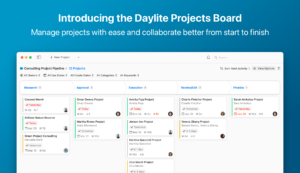Communication is a key part of any relationship; and in relationships details matter. The project details, delegations and changes to projected areas of focus can be overwhelming.
Building in a structured plan and making sure it is adhered to is key. Yet the small details always seem to catch up. Perhaps a feature you thought was negotiable was part of a client’s core expectation or that negotiable wasn’t finalized before submittal. It’s these details that ultimately make-or-break your project that have to be focused on.
Don’t let details slip through the cracks that add up and lead to ruin. Through ample documentation incorporated into your team’s workflow you can streamline your projects and manage all the moving pieces more effectively.
Documenting the Project Scope
Sit down with your team and client to go over the project together. Identify the core needs and expectations. Create a statement that encompasses this scope. It could just be as simple as a few sentences. You’ll want to sum the entire scope – it’ll give you an overall objective to relate back to.
From there, break down the project into three headings: the core components, nice-to-haves and other negotiable items. The point of this is to figure out what the job is as well as what it is not. (This is where the negotiable aspect comes in.)
For example: say a client’s website needs a revamp. Write out what absolutely must be included and if it aligns with the projects overall scope. Once there, map out any of the nice-to-haves or features that could help make the user-experience easier – these are secondary objectives that are still important that back-up the overall scope but aren’t necessarily key to the overall objectives.
Here’s another example: a client is looking for a new home. Going over the main objectives like budget, location and the client’s need-to-have features for the house. Negotiable items come next (like what the counter tops are made from).
Agreeing on the scope and the negotiable items allow your team to have a roadmap of what the core objectives are and where the overall project is going. Later notes on the direction to the scope can be added later if the situation changes.
The main point is to manage the client’s expectations up front. Map out any pain-points and expected deadlines and delegate accordingly.
Tip: Using Daylite Forms, you can capture the project scope in an organized way and link it to the project so anyone in your team can quickly get a refresh on the key must-haves and nice-to haves. The same can be done for a new Opportunity if you’re capturing the scope of a deal.
Documenting the Work Needed
No team is useful without proper communication and acknowledgement. Now that the scope has been set and agreed upon by all parties, branch out from there using that information to organize all the work that needs to be done into tasks.
After you’ve broken down each piece of work into bite-sized chunks, assign due dates as necessary and delegate the work accordingly to each team member responsible so everyone is aligned on what needs to be done by whom and by when. This lifts the burden of memorization and prioritization off of your shoulders and onto the team’s as a whole, bringing everyone onto the same page.
Tip: Use Daylite Projects to map out all the tasks that need to be done for each project. Then delegate the tasks to the appropriate team member and get notified when they’re done.
Take Action: Documenting Meetings and Calls
Every meeting has to have a take-away. Never leave a call or a meeting without jotting down the action items. Relying on memory alone means you’re going to miss out on both key points and details that could otherwise be crucial. Future business depends on attention to detail garnered from these interactions. Don’t let missing details sink you. If you must, delegate someone to take minutes and create actionable items.
Write down as much as possible during your client meetings and phone calls so you have clear actionable items.
It pays to be meticulous. According to Paul Axtell, (a business communications writer for the Harvard Business Review) documenting meeting minutes will save you time and money at the very least. At best it’ll avoid a miscommunication where it turns into a “he-said/she-said” scenario where a task may have gone in a different direction or at worst temperaments may be frayed.
If you’ve taken notes effectively, after the client call or meeting you’ll have a broken down list of exactly what needs to be done and by when. From there you can delegate the work accordingly.
Small-business CRMs come in handy once again here because you can make your notes instantly available to the rest of your team, while keeping it more organized than a shared document. The more notes you take, the less pressure there is on you and your team to constantly be remembering every last detail. As the Chinese proverb goes, “The palest ink is better than the best memory.
Tip: For each call or meeting, use a Daylite note to document meeting minutes then create tasks from there. This way everything is linked to the client and project, and everyone in your team has access to the info.
Conclusion
Don’t let things slip through the cracks because you relied on your memory alone. Document, document, document so you and your team are aligned on every decision, action item, and plan.
About the author:
Xander Cavalier is a former radio broadcaster and community organizer with grass-roots experience in Northern Ontario. He is currently based in the GTA. You may reach out to him on LinkedIn.



